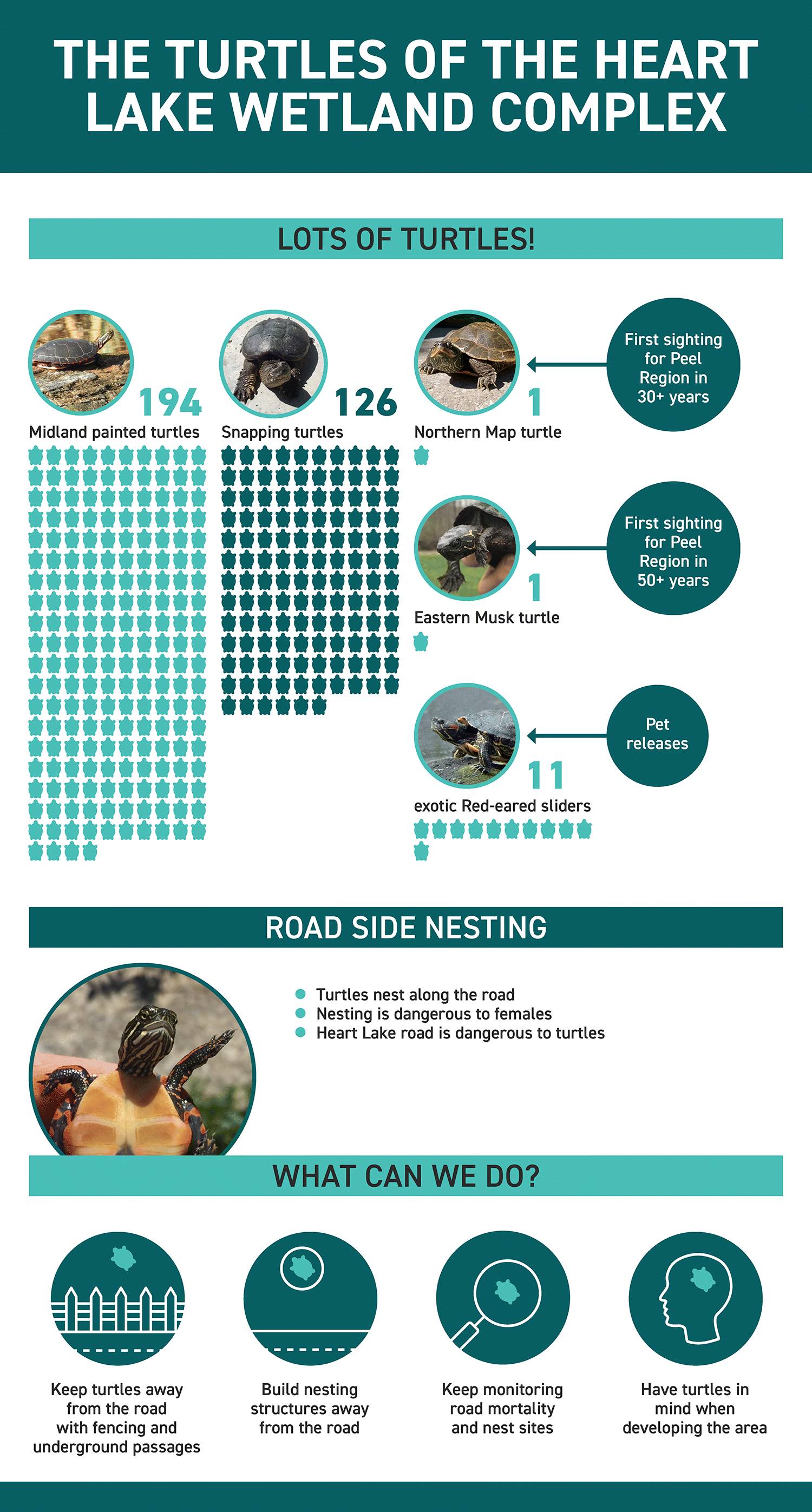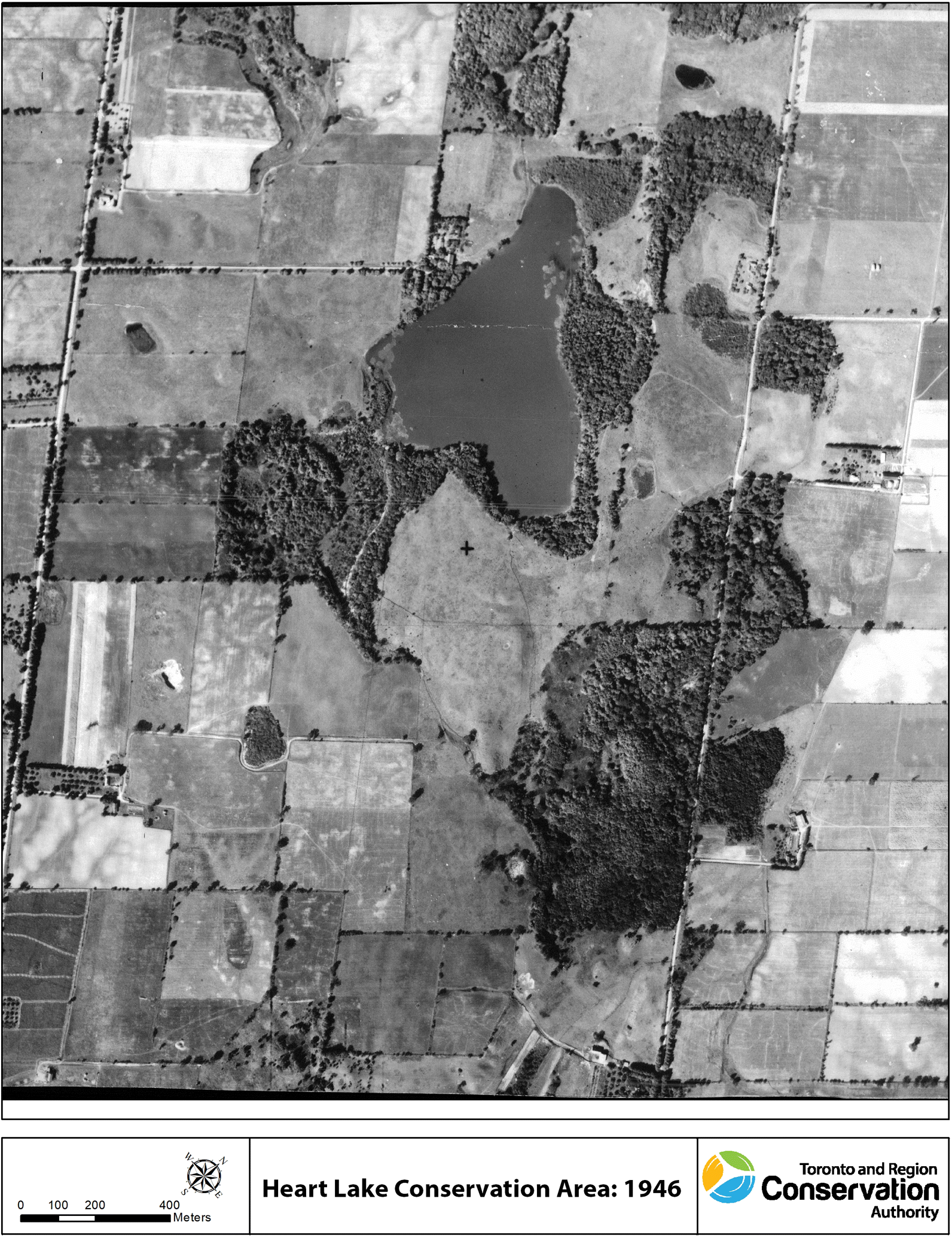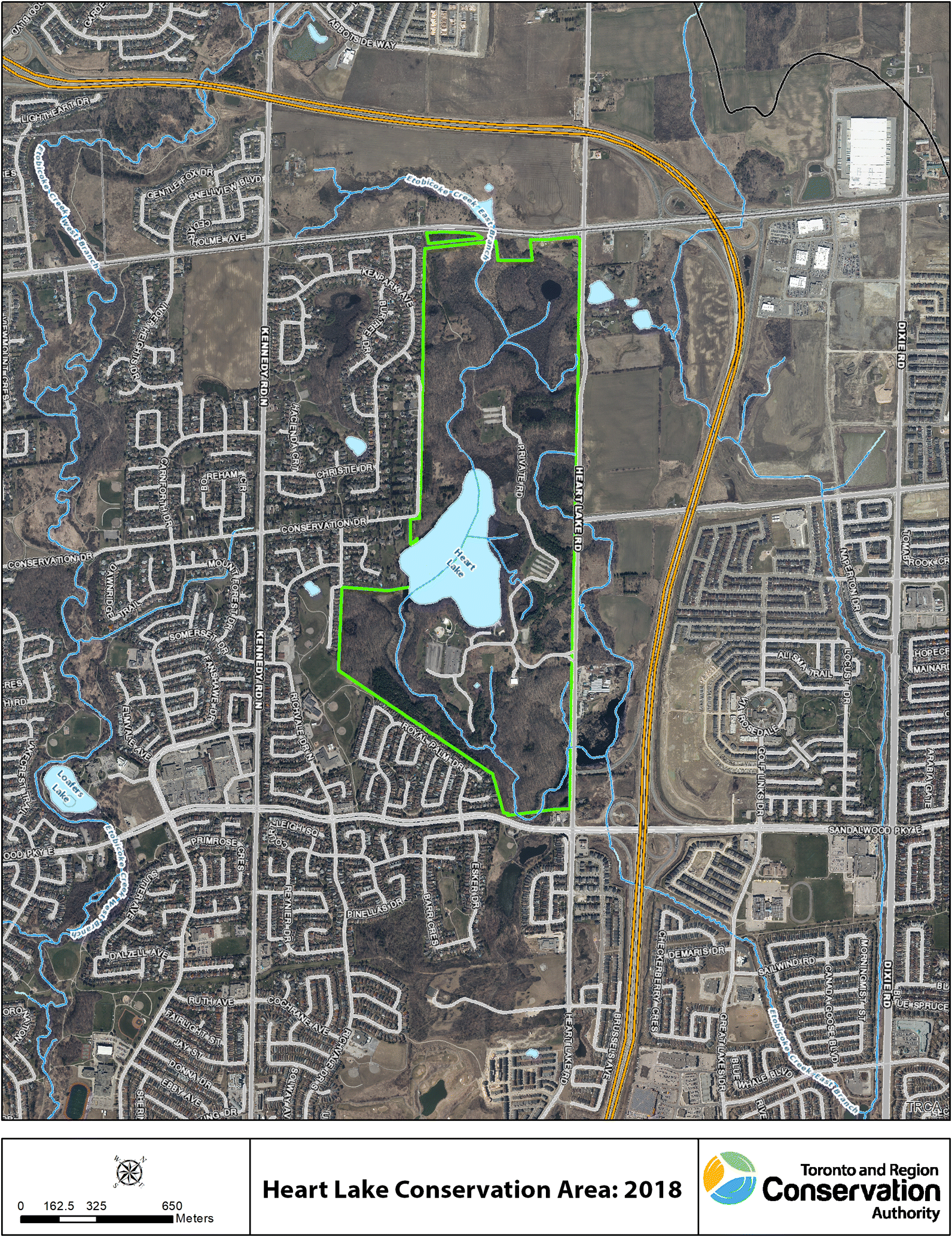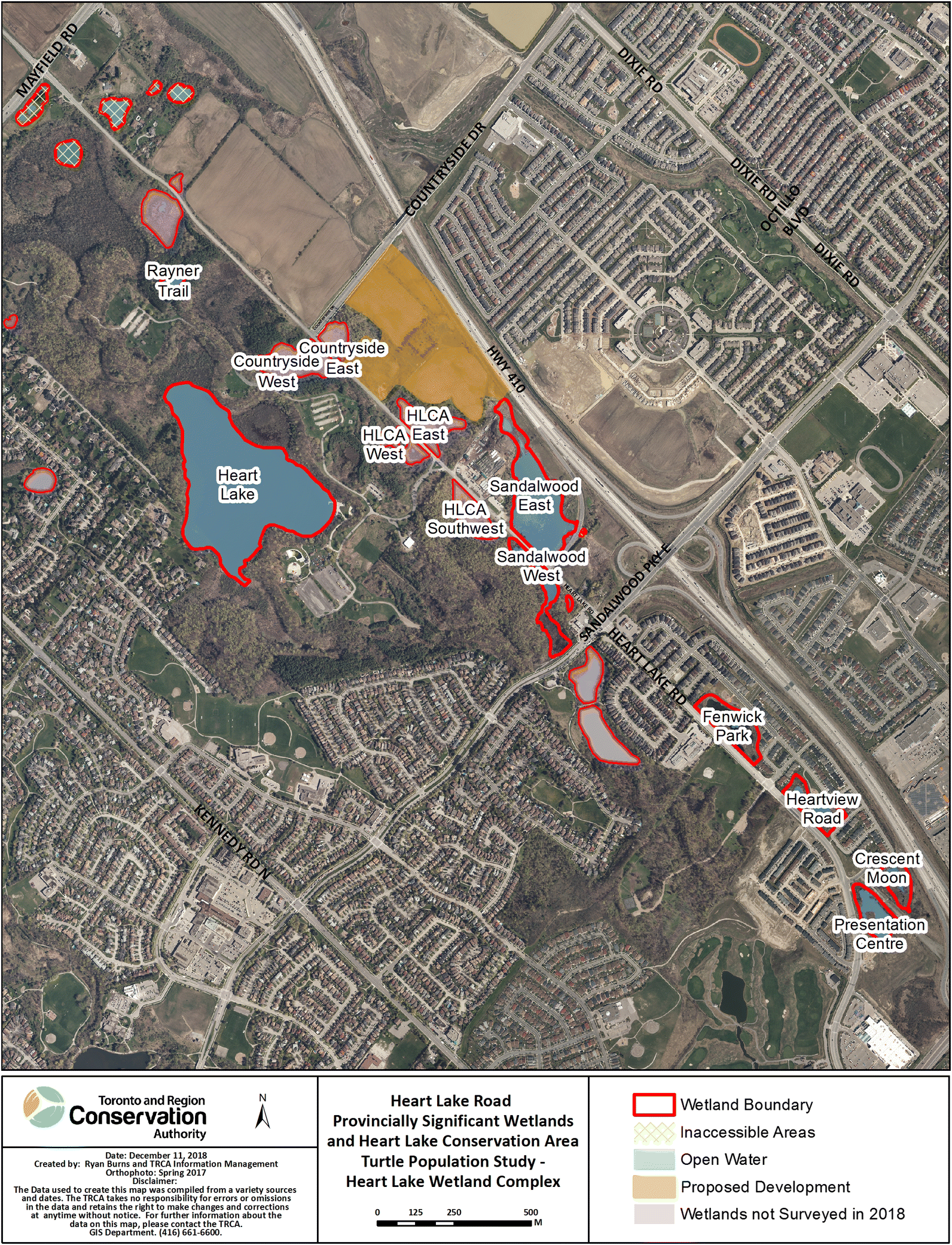Introduction
Freshwater turtles play an important part of the wetland ecosystem, acting as nutrient recyclers, seed dispersers, important predators and prey in the food chain, and they regulate various ecosystem processes such as energy flow and soil dynamics (
Semlitsch and Bodie 2003;
Lovich et al. 2018). Freshwater turtles can exist in high densities (reported up to 877 kg per hectare (
Congdon et al. 1986)) and these high biomass populations can have commensurate impacts on the ecosystem processes. The ability of turtles to bioaccumulate toxins (
Guirlet and Das 2012) and for certain species to thrive in degraded conditions also make them suitable at restoring wetland ecosystems (
Moll 1980;
DeCatanzaro and Chow-Fraser 2010). Turtles are one of the most threatened vertebrate groups globally with 61% of the 356 species threatened or already extinct due to habitat destruction and overexploitation (
Rhodin et al. 2017).
In Ontario, there are eight extant species of turtles. With the recent inclusion of Midland Painted turtles in April 2018, all of Ontario’s turtle species are listed as species at risk by the Committee on the Status of Endangered Wildlife in Canada (COSEWIC)—three as endangered (Spotted turtle,
Clemmys guttata; Spiny Softshell,
Apalone spinifera; and Wood turtle,
Glyptemys insculta), one as threatened (Blanding’s,
Emydoidea blandingii), and four as species of special concern (Midland Painted,
Chrysemys picta marginata; Eastern Snapping,
Chelydra serpentina serpentina; Northern Map,
Graptemys geographica; and Eastern Musk,
Sternotherus odoratus). One species is listed as extirpated (Eastern Box turtle,
Terrapene carolina). Turtle sightings in Ontario are recorded in the Ontario Reptile and Amphibian Atlas (
ontarionature.org/programs/citizen-science/reptile-amphibian-atlas/).
Road density and the accompanying road mortality of turtles play an increasingly important role in both the number and the composition of a turtle population. The effects of roads include habitat fragmentation, barriers to movement, and direct mortality from collisions (
Forman 1998;
Fahrig and Rytwinski 2009;
van der Ree et al. 2011). Turtles are particularly susceptible to road mortality because they move slowly across roads. Populations are susceptible to the impacts of road mortality because of long life spans and late age of sexual maturity and the frequency of overland journeys (
Steen and Gibbs 2004;
Crawford et al. 2014). Roads with several thousand vehicles per lane per day are almost impassable to turtles (
Gibbs and Shriver 2002). Females are especially vulnerable to road mortality during nesting season when they search for suitable nesting sites in loose substrate such as roadside gravel shoulders (
Haxton 2000;
Aresco 2005;
Steen et al. 2006), and as a result, turtle populations in North America are showing evidence of becoming more male biased (
Marchand and Litvaitis 2004;
Gibbs and Steen 2005).
Road mortality affects both male and female turtles but at differing times of the year and to different degrees. In an Ontario study of 2020 turtles admitted to a specialized turtle hospital (Kawartha Turtle Trauma Centre) due to vehicular collisions, there was no sex bias in admissions of Blanding’s, Painted, or Snapping turtles (
Carstairs et al. 2019). Females of these species showed an admissions spike during nesting season (peaking in mid-June), whereas the males were admitted more uniformly throughout the summer. Male Painted turtles also appear to be active for a longer duration every season because they spend significant time seeking mating opportunities (
Moldowan et al. 2018). Only the highly aquatic Northern Map turtle showed a significant female skew in admissions as the females must leave the water to nest, but the males spend most of their adult lives in the water (
Ernst and Lovich 2009). However, admissions rate does not equate to the risk of collisions and only careful demographic studies can shed light on population sex ratios. A study of 77 Great Lakes coastal marshes found a significant male bias in a Painted turtle population in an area with a high road density, whereas areas further from roads had no sex bias (
DeCatanzaro and Chow-Fraser 2010). In contrast, in an analysis of 20 isolated Ontario ponds, abundance and sex ratios of Painted turtles were not affected by distance to the road, although the focus of that study was on isolated ponds with no other bodies of water nearby (
Dorland et al. 2014).
Dupuis-Desormeaux et al. (2018) also found an even sex ratio of Midland Painted and Snapping turtles in an artificial Ontario wetland complex with low vehicular traffic. However, in a study area with high vehicular traffic with a history of turtle road mortality,
Dupuis-Desormeaux et al. (2017) found a heavily male-skewed sex ratio of Painted turtles. However, the causal link between turtle road mortality and population structure remained speculative because the heavy traffic on this road obliterated most specimens in such a way that sexing the dead turtles was not feasible.
The objective of our study was to broaden the
Dupuis-Desormeaux et al. (2017) study at the same study site and establish a baseline of in situ turtle demographics in some of the more important wetlands within the complex to better understand the persistence of turtles within these wetlands contained by an urban landscape matrix. This study site is under continuing pressure to urbanize even further as future habitation development proposals for the immediate area around the wetland complex envisage a new 600-residential unit development and a business park, which will add to the traffic volume of Heart Lake Road. This development will likely further isolate each wetland inside the complex as successful turtle movement between the wetlands becomes less likely. Remnant wetlands can become isolated ecologically, often lacking adequate terrestrial habitat (
Semlitsch and Bodie 2003), a vital component for herpetofauna persistence. Because of this ecological isolation, we also wanted to examine both the main wetlands and the smaller remote remnant wetlands populations for anomalies in assemblage and sex representation and to discuss potential population sources and sinks.
Study site
The Heart Lake wetland complex, Brampton (Peel region), Ontario (43°44′27″N, 79°47′29″W), is approximately 100 ha and is characterized by an 18-ha kettle lake (Heart Lake) and a series of small interconnected wetlands ranging from 2 ha to 8 ha in size. The importance of the Heart Lake wetland complex has been recognized by the Ontario government and has been categorized as a Provincially Significant Wetland, with a score of 850 points (out of a scale of 1000 possible points), the seventh highest score in southern Ontario. An ephemeral tributary creek runs through the main wetland complex and eventually joins the Etobicoke creek that connects to Lake Ontario.
Turtle sightings in Brampton have been limited to Midland Painted and Eastern Snapping turtles (Ontario Amphibian and Reptile Atlas). A Northern Map turtle had been reported in 1987 in a conservation area 10 km away, and no Blanding’s, Spotted, Softshell, Wood or Eastern Musk turtle had ever been reported in the Brampton area.
The Heart Lake wetland complex is situated in the City of Brampton, a suburban city in Southern Ontario that (growing at 13% per year on average between 2011 and 2016), that lies within the Greater Toronto Area. The city is one of the fastest-growing communities in all of Canada with a population of 593 638 residents as of 2016 and has been designated as an urban growth area by the Province of Ontario (
Ontario Ministry of Municipal Affairs and Housing 2019). The current road system is at capacity and some existing roads are being expanded and new roads are being built. The Heart Lake road bisects the Heart Lake wetland complex and has done so since the 1830s, a time when fewer than 2000 residents lived in the area. The area surrounding the wetlands complex moved from agricultural to suburban (
Figs. 1 and
2). The two-lane road is paved (since the mid-70s) with narrow gravel shoulders and has a posted speed limit of 60 km/h. Weeklong vehicular traffic surveys conducted in 2013, 2016, and 2018 along Heart Lake Road recorded total average vehicles per day of 6254, 7103, and 10 400, respectively using automated paired axle sensors (MetroCount, Fremantle, Australia). The other roads that border the wetland complex are Countryside Drive to the north, with an average of 12 777 vehicles per day in 2018, up from 5540 in 2016; Sandalwood Parkway to the south, averaging 32 527 vehicles per day; and to the East is the 410 highway averaging 67 800 vehicles per day at Sandalwood Parkway (
City of Brampton 2019).
Survey methodology
We conducted a capture–mark–recapture (CMR) study over various wetlands within the Heart Lake wetlands complex starting with a single wetland (Heart Lake Conservation Area (HLCA)-east–west) in 2014. In 2014 and 2015, we trapped only the HLCA wetland (
Dupuis-Desormeaux et al. 2017). In 2018, we expanded the scope of the survey by trapping in various new locations within the Heart Lake wetland complex using 30 baited hoop traps between 29 May 2018 and 24 July 2018 (
Fig. 3), as well as a single day of trapping on 9 May 2019.
Within the wetland complex, we differentiated two main categories of wetlands: main wetlands (Heart Lake, Rayner, Sandalwood, HLCA) that were still functionally connected via streams and culverts and isolated remnant wetlands that had become cut off due to urban development. We trapped each wetland using 1-m diameter three-ring hoop nets (no. 15 net with 6.25-cm mesh from Champlin Net Company, Jonesville, Louisiana, USA). The large mesh size precluded the capture of hatchlings or very small turtles making our demographic analysis skewed towards adult and larger juveniles. The hoop traps were baited with a variety of food depending on availability, including frozen trout, canned cat food, and canned sardines. Bait was placed in the water in suspended bags near the back of the traps. Traps were secured by tying them to steel T-bars pushed into the wetland substrate. The traps were positioned in a fashion to leave approximately one-quarter of the trap exposed to the air to let the trapped animals breathe. Traps were checked every 24 h. We trapped each individual wetland over a series of consecutive days or weeks depending on the size of the wetland. Based on visual observations and road mortality findings, we expected to find Midland Painted, Snapping turtles, and a few exotic Red-eared sliders (
Trachemys scripta elegans) in our survey. Captured turtles were processed on shore, where we recorded mass using both digital and analogue scales and measured body morphology using Vernier calipers or Haglöf tree calipers for the larger turtles to the nearest 1 mm. We collected straight carapace length, carapace width, plastron and mid-plastron (posterior lobe) lengths (depending on the turtle species), forelimb nail length, and pre-cloacal length (PCL). Morphological data are used to sex and age (unsexed juveniles versus adults) the turtles and to give insight into any physical abnormalities of these populations. We sexed Midland Painted turtles by nail length and PCL, Eastern Snapping turtles either by genitalia eversion (
Dustman 2013) or by the ratio of the PCL to the posterior lobe length (PPR), and sexed using accepted methods (male PPR > 1.2, females <1.2) (
Ernst and Lovich 2009). For the Red-eared sliders, we used the flatter carapace, the position of the cloacal opening and the longer curved foreclaws to differentiate the males. For the Northern Map turtle, we sexed our sole specimen easily as it was laying eggs when captured. We sexed the Eastern Musk turtle using tail length and the ratio of plastron length to carapace length. We notched the marginal carapacial scutes of all captured turtles using a unique identifying code to allow for individual recognition once recaptured (
Cagle 1939).
We estimated the population of Midland Painted and Eastern Snapping turtles in each wetland by performing a CMR effort for several days or weeks and applying a Schnabel estimator (
Krebs 2009). The estimation model has a few assumptions that should not be violated, i.e., a closed population (no deaths, births, emigration, or immigration during the sampling), equal probability of capture between samples, and that marked specimens can be recognized upon recapture. Population estimates derived from this model represents a rough estimation of catchable turtles, which is a subset of the actual population.
We grouped individual wetlands that were proximate (within approximately 150 m, i.e., Sandalwood east with west and Heart Lake with Rayner), and estimated the turtle population in these two main wetland groupings and the species density for the groupings. We estimated population density by dividing the estimated number of turtles by the available turtle habitat (3 m or less of water depth) in each body of water (
Galbraith et al. 1988).
To determine if the sex ratios were unbiased, we performed a nonparametric two-sided test based on a one-sample binomial distribution (
Wilson and Hardy 2002). Expected sex ratios for both Midland Painted and Snapping turtles were 1:1 (
Ernst and Lovich 2009).
In conjunction with the installation of new temporary fencing designed to keep turtles off the road, we conducted a roadside turtle nest survey between Sandalwood and Countryside roads (close to the major wetlands but not near the remnant wetlands) between 6 June and 27 August 2018 by having dedicated volunteers walk the Heart Lake road when possible and no less than once a week and record possible turtle nests and noting if these showed signs of depredation (nest destruction with egg shells outside of nest). We did not examine upland areas for nests but concentrated on only roadside nesting success. Undoubtedly many upland locations are used as nesting sites. Possible nests were identified by noting newly disturbed indentations in the gravel and sand, placing a marking flag near it, and taking a GPS waypoint. Females will dig one or more trial nest cavities (
Ernst and Lovich 2009), so we expected that many possible nest sites would be trial holes. We could not discriminate between trial nests and real nests without disturbing the nest and inspecting the content or seeing the turtle laying her eggs; therefore, we present the data as a possible nests knowing that these data will likely overestimate the real number of nests present by the roadside.
Results
In 2018–2019, we captured 431 turtles (333 new and 98 recaptured) over 32 d using 30 traps per day representing a catch per unit effort of 44.9% (see
Supplementary Material for data set). At the wetland complex level, we found 194 Midland Painted turtles (84 males, 84 females, and 26 unsexed juveniles), 126 Eastern Snapping turtles (57 males, 58 females, and 11 unsexed juveniles), 1 Northern Map turtle (1 female), 1 Eastern Musk turtle (1 female) and 11 exotic Red-eared sliders (9 adult females and 2 adult males, no juveniles). We added the original wetland data collected in 2014–2016 to the table of data ollected in 2018 to present a more fulsome picture of the Heart Lake wetland complex in
Table 1.
The male to female sex ratio of Midland Painted turtles was unbiased at the wetland complex level; however, it showed a strong male bias (33:19,
p = 0.018) in the wetland that was directly bisected by the Heart Lake road (Sandalwood east–west wetland). The sex ratio of Snapping turtles was unbiased at both the wetland complex level and in each individual wetland. The ratio of Midland Painted turtles to Snapping turtles at the wetland complex level was 1.7:1 but varied greatly between individual wetlands (from 0 to 4.9). Body morphology of adult turtle specimens is presented in
Table 2 and was within the norm for each species (
Ernst and Lovich 2009). The nesting survey found 36 potential nest sites along the wetland side of the new fencing along the road, of which 25 had been eventually depredated, the others were likely test holes. Although the predation rate of roadside nests was very high, we were encouraged by the fact that turtles were successfully contained to the wetland side by the fencing, greatly reducing the risks to the nesting females.
The number and density of turtles (number of turtles per hectare of available wetland) varied between the wetland groups (
Table 3). We provide estimates of the turtle population within the larger wetland groupings for illustrative purposes only as we feel that some of the assumptions of population models were likely violated due to low numbers of recaptured turtles and potential trap shyness once captured leading to unequal catchability. There were also multiple potential trapping locations that were too difficult to access; therefore, we don’t believe that we were able to get an even representation of the whole available habitat.
Discussion
Turtles were captured in every surveyed wetland within the wetland complex and this result in itself was remarkable given the increasing isolation of each wetland due to rising traffic volume and urbanization pressures. Some of these urban factors that can negatively affect turtle populations include increased numbers of subsidized predators such as raccoon (
Procyon lotor), fox (
Vulpes vulpes), mink (
Neovison vison), skunk (
Mephitis mephitis), and opossum (
Didelphis virginiana) (
Browne and Hecnar 2004;
Marchand and Litvaitis 2004;
Beaudry et al. 2008); off-leash dogs; lack of upland habitat; and probable degraded water quality. Wetland productivity and turtle assemblage varied considerably between wetland groups. Of note was the presence of a female Northern Map turtle and a female Eastern Musk turtle captured in Heart Lake, two species with no prior record in that immediate area. The last sightings of Map turtles and Eastern Musk turtles in Peel region was in 1987 and 1969, respectively (
COSEWIC 2012). It is difficult to know if these two specimens reflect small local populations that have persisted and have gone undetected or if these specimens were the result of recent natural arrivals via the Etobicoke creek and its tributaries or if they are the result of a human facilitated transfer from another jurisdiction. We are inclined to believe that these two species have gone undetected in the lake. The female Northern Map turtle could have been easily mistaken for the Red-eared slider as it is similar in size and shape to the exotic slider, a turtle that is ubiquitous in urban ponds as a result of pet releases. The Eastern Musk turtle is a small highly aquatic turtle that basks under floating vegetation and is seldom seen basking on logs or rocks, potentially and easily avoiding detection.
We were surprised by the absence of Midland Painted turtles from many of the smaller isolated wetlands that appeared to have a similar habitat to the larger wetlands that also contained only adult Snapping turtles. Data showed that four of the eight ponds had no Midland Painted turtles and that five of the eight wetlands had no captured juvenile Snapping turtles. The lack of juvenile Snapping turtles is another warning sign that these remnant wetlands are not functioning normally. Potential explanatory factors could be a low recruitment rate due to nest depredation as our data suggest high nest predation at the main wetlands. Although we did not perform nest surveys near the smaller remnant wetlands, we can expect that nest predation is at least as severe at those sites, given that the turtles residing within the remnant wetlands have fewer upland choices for nesting habitat. Nesting habitat in the remnant wetlands is mostly restricted to the roadside. The larger size of adult Snapping turtles could help detection by motorists if the turtles happen to stray on or near the roads, consequently leading to longer persistence in these remnant wetlands than the smaller Midland Painted turtles. Local predators could also be preferentially selecting Painted turtles because of their smaller size. The overall ratio of 1.7:1 Painted turtles to Snapping turtles was skewed towards Snapping turtles compared with other lake wetland assemblages (
DeCatanzaro and Chow-Fraser 2010) and was more akin to what has been described for remnant and artificial ponds as was the high density of turtles per hectare (
Galbraith et al. 1988;
Bodie and Semlitsch 2000;
Hughes et al. 2016).
There is a striking difference between the productivity of the Presentation–Crescent group versus the Fenwick–Heartview groups of remnant wetlands. One of the more obvious topographical contrasts is that upland habitat is available to turtles within the Presentation–Crescent group without having to cross Heart Lake road, whereas both Fenwick and Heartview wetlands have upland habitat available nearby but that requires a treacherous crossing of the main road. However, the area around Presentation–Crescent is tabled for future development and when that happens, those two wetlands will be completely isolated with no easily reachable upland habitat, not even across the road. We fear that these two groups of remnant wetlands are now so isolated as to be virtually unreachable by turtles migrating from the main wetlands of Heart Lake or Sandalwood and that these remnant wetlands are probable population sinks. Although the two wetlands that are bisected by Heart Lake road and the Sandalwood and HLCA wetlands are showing a male sex skew, they also both appear to be very productive and are recruiting juveniles into their population; we would consider these a population source as we would for the main wetlands of Heart Lake.
The wetland complex did not show any biased sex ratios, which is in keeping with another study we performed at an artificial wetland complex in the Greater Toronto Area (
Dupuis-Desormeaux et al. 2018). However, at the individual wetland scale, one wetland grouping (Sandalwood) showed a male-biased sex ratio for Midland Painted turtles. That grouping was directly bisected by the Heart Lake road as was the previously studied wetland (HLCA) (
Dupuis-Desormeaux et al. 2017). This result combined with the overall equal sex ratios elsewhere within the complex highlights the importance of both road proximity and of local habitat features, i.e., having wetland habitat on both sides of the road may increase the risks of road mortality versus simply having a road nearby. These results underscore the importance of safe travel corridors within a wetland complex and available upland habitat. This study also highlights the dangers of increasing isolation for turtle populations in remnant wetlands. Urbanization continues to reduce available habitat and recruitment of juveniles into the population appears to be very poor. It is unlikely that these remnant wetlands can be reconnected to the main wetlands of the complex. At this time, it may be more efficient to focus efforts at these remnant wetlands on safeguarding the in situ population by erecting turtle-specific fencing preventing turtles to access the road shoulders and providing alternative nesting options such as artificial nesting structures to enhance recruitment.
One last point to note is that conducting this population survey has led to an increased engagement and awareness in the community and better understanding of the needs for habitat protection at the municipal level. The Municipality of Brampton in partnership with the Toronto and Region Conservation Authority has been discussing various ways to mitigate the threats and improve the habitat of turtles. We hope to detail the social developments resulting from this study as well as on-going road mortality surveys in a different manuscript.
Acknowledgements
We would like to thank Alex Désormeaux, Wouter Schaake, Bruna Peloso, David Lawrie, Jonathan Ruppert, Tisha Tan, and Casey Cook, for their help with trapping and processing as well as special thanks to Tomide Adeyale for the nesting survey. This study was funded by the Toronto and Region Conservation Authority.





